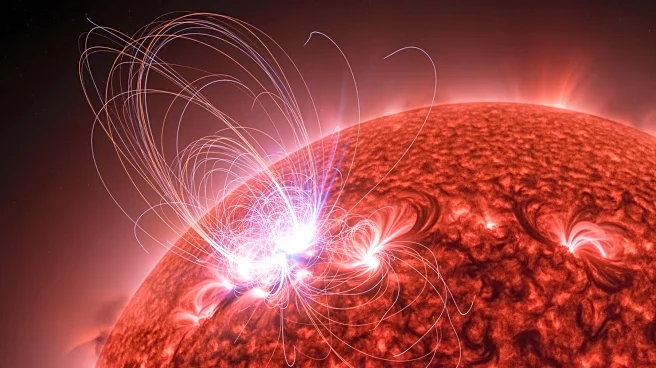What's Happening?
Researchers at the Institute for Astronomy at the University of Hawai'i have uncovered new insights into the phenomenon of coronal rain on the Sun. This rain, composed of superheated plasma, is influenced
by quickly shifting flows of elements such as iron, silicon, and magnesium. These shifts affect radiative energy loss, causing temperature drops at the peak of coronal loops, which in turn triggers a cooling effect resulting in coronal rain. The study challenges previous assumptions that elemental abundances in the Sun's corona were constant, revealing that variations in these elements can lead to the formation of coronal rain within minutes. This discovery provides a deeper understanding of the Sun's magnetic fields and the dynamics of its atmosphere.
Why It's Important?
Understanding coronal rain is crucial for comprehending the Sun's atmospheric dynamics and magnetic field interactions. This research has implications for solar physics, potentially influencing models of solar activity and predictions of space weather. Accurate models of the Sun's behavior are essential for anticipating solar flares and other phenomena that can impact satellite operations, communication systems, and power grids on Earth. The findings also contribute to the broader field of astrophysics, offering insights into the processes governing stellar atmospheres and magnetic fields. This knowledge is vital for advancing scientific understanding of the universe and improving technologies reliant on solar observations.
What's Next?
The discovery of the mechanism behind coronal rain opens new avenues for research in solar physics. Scientists may revisit existing models of the Sun's atmosphere to incorporate these findings, potentially leading to more accurate predictions of solar activity. Further studies could explore the implications of shifting elemental abundances on other solar phenomena, such as coronal heating. Researchers may also investigate the potential applications of this knowledge in developing technologies that harness solar energy or improve space weather forecasting. Collaborative efforts between institutions could enhance the understanding of the Sun's complex dynamics, contributing to advancements in both theoretical and applied astrophysics.
Beyond the Headlines
The study of coronal rain on the Sun highlights the intricate relationship between elemental abundances and solar phenomena. This research underscores the importance of interdisciplinary approaches in astrophysics, combining observational data with theoretical models to unravel complex processes. The findings may inspire discussions on the role of elemental variations in other celestial bodies, potentially influencing the study of planetary atmospheres and magnetic fields. Additionally, the research emphasizes the need for continuous exploration of the universe, fostering innovation and discovery in the scientific community.













